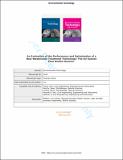| dc.contributor.author | Forde, P. | |
| dc.contributor.author | Kennelly, Colm | |
| dc.contributor.author | Gerrity, Seán | |
| dc.contributor.author | Collins, Gavin | |
| dc.contributor.author | Clifford, Eoghan | |
| dc.date.accessioned | 2019-03-26T15:00:17Z | |
| dc.date.available | 2019-03-26T15:00:17Z | |
| dc.date.issued | 2014-12-09 | |
| dc.identifier.citation | Forde, P., Kennelly, C., Gerrity, S., Collins, G., & Clifford, Eoghan. (2015). An evaluation of the performance and optimization of a new wastewater treatment technology: the air suction flow-biofilm reactor. Environmental Technology, 36(9), 1188-1204. doi: 10.1080/09593330.2014.982724 | en_IE |
| dc.identifier.issn | 1479-487X | |
| dc.identifier.uri | http://hdl.handle.net/10379/15056 | |
| dc.description.abstract | In this laboratory study, a novel wastewater treatment technology, the air suction flow-biofilm reactor (ASF-BR) - a sequencing batch biofilm reactor technology with a passive aeration mechanism - was investigated for its efficiency in removing organic carbon, nitrogen and phosphorus, from high-strength synthetic wastewaters. A laboratory-scale ASF-BR comprising 2 reactors, 350 mm in diameter and 450 mm in height, was investigated over 2 studies (Studies 1 and 2) for a total of 430 days. Study 1 lasted a total of 166 days and involved a 9-step sequence alternating between aeration, anoxic treatment and settlement. The cycle time was 12.1 h and the reactors were operated at a substrate loading rate of 3.60 g filtered chemical oxygen demand (CODf)/m(2) media/d, 0.28 g filtered total nitrogen (TNf)/m(2) media/d, 0.24 g ammonium-nitrogen (NH4-N)/m(2) media/d and 0.07 g ortho-phosphate (PO4-P)/m(2) media/d. The average removal rates achieved during Study 1 were 98% CODf, 88% TNf, 97% NH4-N and 35% PO4-P. During Study 2 (264 days), the unit was operated at a loading rate of 2.49 g CODf/m(2) media/d, 0.24 g TNf/m(2) media/d, 0.20 g NH4-N/m(2) media/d and 0.06 PO4-P/m(2) media/d. The energy requirement during this study was reduced by modifying the treatment cycle in include fewer pumping cycles. Removal rates in Study 2 averaged 97% CODf, 86% TNf, 99% NH4-N and 76% PO4-P. The excess sludge production of the system was evaluated and detailed analyses of the treatment cycles were carried out. Biomass yields were estimated at 0.09 g SS/g CODf, removed and 0.21 g SS/g CODf, removed for Studies 1 and 2, respectively. Gene analysis showed that the use of a partial vacuum did not affect the growth of ammonia-oxidizing bacteria. The results indicate that the ASF-BR and passive aeration technologies can offer efficient alternatives to existing technologies. | en_IE |
| dc.description.sponsorship | The authors would like to acknowledge the financial support provided by Enterprise Ireland who
funded this research project (Grant No CFTD-2008-315). The authors also thank M. Barrett and K.
Kilroy for kindly providing bacterial and amoA plasmids for real-time PCR experiments. This
publication has also emanated from research conducted with the financial support of the European
Research Council (ERC Starting Grant #: 2613303 “C-BIOTECH”). | en_IE |
| dc.format | application/pdf | en_IE |
| dc.language.iso | en | en_IE |
| dc.publisher | Taylor & Francis | en_IE |
| dc.relation.ispartof | Environmental Technology | en |
| dc.rights | Attribution-NonCommercial-NoDerivs 3.0 Ireland | |
| dc.rights.uri | https://creativecommons.org/licenses/by-nc-nd/3.0/ie/ | |
| dc.subject | sequencing batch biofilm reactor | en_IE |
| dc.subject | low energy | en_IE |
| dc.subject | biofilm | en_IE |
| dc.subject | biofilm analysis | en_IE |
| dc.subject | high-strength synthetic wastewater | en_IE |
| dc.subject | SEQUENCING BATCH REACTOR | en_IE |
| dc.subject | AMMONIA-OXIDIZING BACTERIA | en_IE |
| dc.subject | MEMBRANE BIOREACTOR | en_IE |
| dc.subject | LANDFILL LEACHATE | en_IE |
| dc.subject | NITROGEN REMOVAL | en_IE |
| dc.subject | TREATMENT PLANTS | en_IE |
| dc.subject | SYSTEM | en_IE |
| dc.subject | SLUDGE | en_IE |
| dc.subject | QUANTIFICATION | en_IE |
| dc.subject | REDUCTION | en_IE |
| dc.title | An evaluation of the performance and optimization of a new wastewater treatment technology: the air suction flow-biofilm reactor | en_IE |
| dc.type | Article | en_IE |
| dc.date.updated | 2019-03-22T16:25:48Z | |
| dc.identifier.doi | 10.1080/09593330.2014.982724 | |
| dc.local.publishedsource | https://doi.org/10.1080/09593330.2014.982724 | en_IE |
| dc.description.peer-reviewed | peer-reviewed | |
| dc.contributor.funder | Enterprise Ireland | en_IE |
| dc.contributor.funder | European Research Council | en_IE |
| dc.internal.rssid | 8544387 | |
| dc.local.contact | Eoghan Clifford, Room 1035, Alice Perry Engineering Building, Nui Galway, Galway. 2219 Email: eoghan.clifford@nuigalway.ie | |
| dc.local.copyrightchecked | Yes | |
| dc.local.version | ACCEPTED | |
| dcterms.project | info:eu-repo/grantAgreement/EC/FP7::SP2::ERC/261330/EU/Cold Carbon Catabolism of Microbial Communities underprinning a Sustainable Bioenergy and Biorefinery Economy/3CBIOTECH | en_IE |
| nui.item.downloads | 263 | |


